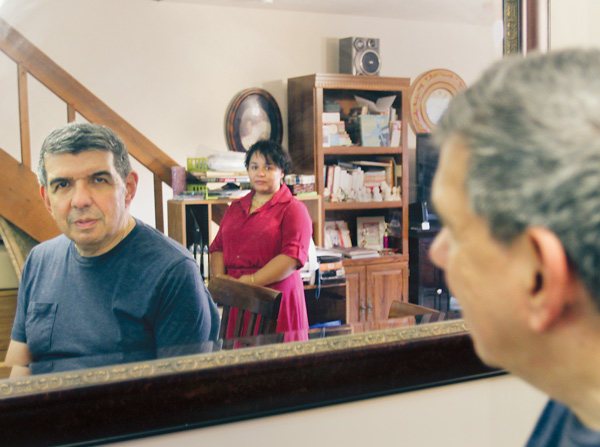Surgery provides hope for minister with Parkinson’s


Nathan Rivera of Austintown looks at a reflection of himself and his wife, Elizabeth, in their home. Before surgery, Rivera struggled with Parkinson’s for a year.
AUSTINTOWN
Nathan Rivera could not stop shaking last year.
The 59-year-old correctional officer and minister from Austintown suffered from tremors due to Parkinson’s disease, with which he was diagnosed in October 2012.
“I was surprised but I accepted it,” he said.
After his diagnosis, however, Rivera started researching for information about his disease.
The symptoms started piling up mostly on the right side of his body, he said. He was constantly shaking, his right leg dragging whenever he walked. Occasionally he would freeze in place without realizing it.
Writing became one of his biggest challenges, which made his work difficult at the Northeast Ohio Correctional Center, 2240 Hubbard Road, and Spanish Evangelical Church, 2530 South Ave., where he is a church associate.
“I just couldn’t control the shaking,” Rivera said. His condition did not improve, even with medication.
Fortunately, Rivera was able to keep his job, and his wife helped with everyday tasks. But he knew a permanent solution was in order.
Rivera was qualified by a specialist to undergo the deep-brain stimulation treatment.
The surgery requires electrodes placed deep in the brain, connected to a pacemaker device implanted in the chest, below the collarbone. The device sends continuous electrical pulses to modify the brain circuits, which trigger the motor symptoms of Parkinson’s disease.
Rivera would have to be conscious during the second half of the surgery to ensure the electrodes are hitting the right areas of the brain.
“I want to be sure the benefits outweigh the risk,” said Dr. Darlene Lobel, Rivera’s surgeon from the Cleveland Clinic.
Although the surgery is commonly performed, the risk of infection has a national average of 5 percent, she said. There also was a 1 percent chance of stroke if a blood vessel was damaged.
Though uneasy about the risks, Rivera decided to undergo the surgery, which occurred on Halloween 2013.
“It took a little courage getting used to,” he said.
Since then, Rivera can walk normally and experiences little shaking.
“They say I improved by 75 percent,” Rivera said.
After the surgery, Rivera returned to work two months later and visits his doctor once a month to check up on his progress.
The battery to the pacemaker will need to be replaced every three years, Dr. Lobel said.
“He has responded extremely well to surgery,” she said.
Despite the minor inconveniences, Rivera said he encourages others, who share his disease, to take chances like he did.
“I don’t regret that I took it [the operation],” he said. “At least this way I’m able to function.”
 43
43
